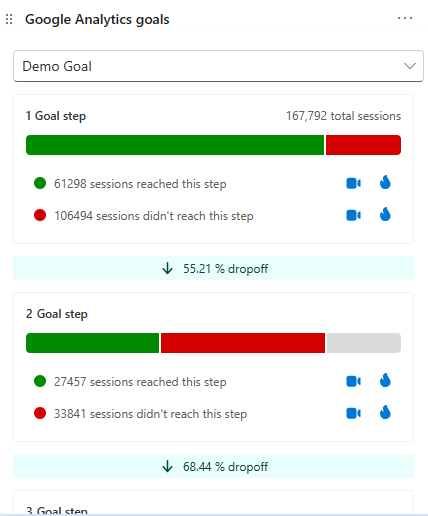Discover the Limitations of Google Analytics Goals: Introducing the Data Types That Remain Untrackable
As services increasingly count on data-driven decision-making, comprehending the limitations of devices like Google Analytics comes to be extremely important. While Google Analytics Goals offer important understandings into individual communications, there exist data kinds that elude monitoring, positioning obstacles to a thorough understanding of individual actions. These untrackable data kinds question concerning the precision and completeness of the analytics data that companies heavily trust for their digital methods. Curious to discover the hidden dead spots in your data evaluation procedure?
Insufficient Customer Journey Tracking
Insufficient individual journey monitoring within Google Analytics can impede the capacity to accurately assess user behavior. When the customer trip is not totally tracked, there are spaces in the information that protect against a comprehensive understanding of how users engage with a website. This absence of understanding can lead to missed opportunities for optimization and improvements to the customer experience.
One usual concern with insufficient individual trip tracking is the inability to see the complete course that customers take in the past finishing an objective or leaving the website. Without this info, it is challenging to identify where users might be encountering barriers or friction points that avoid them from transforming. Additionally, incomplete monitoring can obscure the influence of particular marketing initiatives or site changes on customer actions.
To resolve this limitation, it is crucial to establish up appropriate tracking devices within Google Analytics to catch the entire customer journey. This might include establishing event monitoring, objective funnels, or utilizing tools like Google Tag Manager to ensure that no vital interactions go unrecorded. By acquiring a detailed sight of the user trip, web site proprietors can make more informed choices to enhance customer involvement and drive conversions.
Attribution Obstacles
Navigating via acknowledgment challenges in Google Analytics calls for a comprehensive understanding of exactly how different touchpoints add to the general conversion procedure. Attribution obstacles occur from the intricacy of modern consumer journeys, where individuals interact with several networks prior to transforming. Google Analytics gives various acknowledgment models like very first touch, last touch, and straight, each offering a various perspective on how credit rating is designated to touchpoints along the conversion course. These versions may not constantly precisely mirror the true impact of each touchpoint on the conversion.
One usual attribution difficulty is the problem in associating conversions to the correct source, specifically in instances where customers engage with multiple networks before converting. In addition, cross-device tracking positions an additional acknowledgment obstacle, as individuals commonly switch between tools throughout their trip, making it challenging to track their interactions seamlessly.
Offline Conversions
Given the difficulties linked with connecting conversions properly in online channels, the dimension of offline conversions presents a significant possibility for marketing experts seeking an extra comprehensive understanding of their clients' journey. Offline conversions describe activities that clients take in the real world, such as making purchases in brick-and-mortar shops or over the phone, going to occasions, or involving with printed materials - what data is google analytics goals unable to track. These conversions are vital for businesses that operate both online and offline, as they offer useful insights right into the effectiveness of advertising and marketing campaigns across different touchpoints
Tracking offline conversions traditionally presented a substantial obstacle for online marketers, as it was testing to connect these activities back to particular on the internet communications properly. With innovations in modern technology, such as the integration of CRM systems, unique identifiers, and discount coupon codes, businesses can currently link the void in between online and offline information to gain a much more alternative view of customer habits. By properly gauging offline conversions, marketing experts can maximize their techniques, designate sources extra effectively, and ultimately improve the general customer experience.
Cross-Device Monitoring
Cross-device monitoring plays a vital function in comprehending the interconnected nature of customers' digital communications throughout multiple tools. In today's omnichannel world, where users seamlessly change between smart devices, desktop computers, and tablet computers, tracking their habits throughout these gadgets is vital for online marketers to gain a detailed sight of their client journey.

Furthermore, privacy worries and policies such as GDPR and CCPA have even more challenging cross-device tracking. With customers demanding more control over their data and enhanced restrictions on tracking modern technologies, marketing experts must discover cutting-edge and privacy-compliant means to connect customer interactions throughout devices.
Dynamic Content Interaction
Comprehending customer interaction with dynamic web content is essential in optimizing electronic marketing strategies for improved audience interaction. Dynamic web content describes website components that alter based upon user behavior, choices, or other aspects, offering a personalized experience. Nonetheless, tracking customer interactions with vibrant web content positions difficulties for conventional analytics devices like Google Analytics.
While Google Analytics can track fundamental interactions like clicks and web page sights, it may have a hard time to capture more nuanced engagements within vibrant web content. what data is google analytics goals unable to track. Metrics such as time invested in details dynamic elements, float activities, or communications within pop-ups are commonly not quickly measurable making use of standard monitoring approaches. This limitation impedes marketing experts' ability to fully understand just how customers are engaging with vibrant material and tailor their approaches as necessary

Final Thought
In verdict, Google Analytics objectives have restrictions in tracking insufficient user trips, associating conversions properly, recording offline conversions, tracking cross-device interactions, and determining vibrant content engagement. These restrictions highlight the value of exploring additional tracking techniques and tools to get a much more detailed understanding of user behavior and conversions beyond what Google Analytics can provide.
While Google Analytics Goals offer useful understandings right into customer interactions, there exist data types that elude monitoring, posing difficulties to a comprehensive understanding of individual habits.Incomplete customer trip tracking within Google Analytics can prevent the capacity to accurately assess user actions. When the Recommended Site individual journey is Going Here not fully tracked, there are voids in the information that prevent a comprehensive understanding of exactly how users connect with an internet site.One typical concern with insufficient customer trip monitoring is the lack of ability to see the complete course that customers take previously finishing an objective or leaving the website. By getting a detailed sight of the user journey, website proprietors can make even more enlightened decisions to improve user involvement and drive conversions.